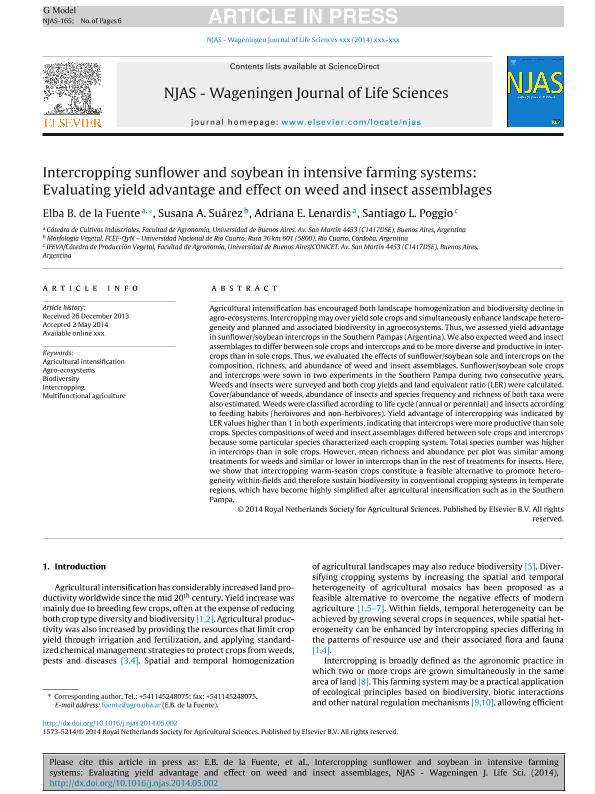Artículo
Intercropping sunflower and soybean in intensive farming systems: evaluating yield advantage and effect on weed and insect assemblages
Fecha de publicación:
05/2014
Editorial:
Elsevier
Revista:
Njas - Wageningen Journal of Life Sciences
ISSN:
1573-5214
Idioma:
Inglés
Tipo de recurso:
Artículo publicado
Clasificación temática:
Resumen
Agricultural intensification has encouraged both landscape homogenization and biodiversity decline inagro-ecosystems. Intercropping may over yield sole crops and simultaneously enhance landscape hetero-geneity and planned and associated biodiversity in agroecosystems. Thus, we assessed yield advantagein sunflower/soybean intercrops in the Southern Pampas (Argentina). We also expected weed and insectassemblages to differ between sole crops and intercrops and to be more diverse and productive in inter-crops than in sole crops. Thus, we evaluated the effects of sunflower/soybean sole and intercrops on thecomposition, richness, and abundance of weed and insect assemblages. Sunflower/soybean sole cropsand intercrops were sown in two experiments in the Southern Pampa during two consecutive years.Weeds and insects were surveyed and both crop yields and land equivalent ratio (LER) were calculated.Cover/abundance of weeds, abundance of insects and species frequency and richness of both taxa werealso estimated. Weeds were classified according to life cycle (annual or perennial) and insects accordingto feeding habits (herbivores and non-herbivores). Yield advantage of intercropping was indicated byLER values higher than 1 in both experiments, indicating that intercrops were more productive than solecrops. Species compositions of weed and insect assemblages differed between sole crops and intercropsbecause some particular species characterized each cropping system. Total species number was higherin intercrops than in sole crops. However, mean richness and abundance per plot was similar amongtreatments for weeds and similar or lower in intercrops than in the rest of treatments for insects. Here,we show that intercropping warm-season crops constitute a feasible alternative to promote hetero-geneity within-fields and therefore sustain biodiversity in conventional cropping systems in temperateregions, which have become highly simplified after agricultural intensification such as in the SouthernPampa.
Archivos asociados
Licencia
Identificadores
Colecciones
Articulos(IFEVA)
Articulos de INST.D/INV.FISIOLOGICAS Y ECO.VINCULADAS A L/AGRIC
Articulos de INST.D/INV.FISIOLOGICAS Y ECO.VINCULADAS A L/AGRIC
Articulos(OCA PQUE. CENTENARIO)
Articulos de OFICINA DE COORDINACION ADMINISTRATIVA PQUE. CENTENARIO
Articulos de OFICINA DE COORDINACION ADMINISTRATIVA PQUE. CENTENARIO
Citación
de la Fuente, Elba Beatriz; Suárez, Susana A.; Lenardis, Adriana Ester; Poggio, Santiago Luis; Intercropping sunflower and soybean in intensive farming systems: evaluating yield advantage and effect on weed and insect assemblages; Elsevier; Njas - Wageningen Journal of Life Sciences; 70-71; 5-2014; 47-52
Compartir
Altmétricas




